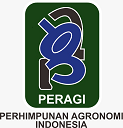Potensi Alelopati Ekstrak Jerami Padi pada Dua Jenis Gulma dan Tanaman Kedelai
Abstract
Keywords
Full Text:
PDFReferences
A.Sumathi, D. (2013). Evaluation of physiochemical and phytochemical parameters of Melia. International Journal of Pharmacy and Pharmaceutical Sciences, 5(1).
Abbas, T., Nadeem, M. A., Tanveer, A., & Chauhan, B. S. (2017). Can hormesis of plant-released phytotoxins be used to boost and sustain crop production? Crop Protection, 93, 69–76. https://doi.org/10.1016/j.cropro.2016.11.020
Afridi, R. A., Khan, M. A., Hussain, Z., Saleem, S., Khan, S., Afridi, K., & Ali, M. (2013). Allelopathic Effects of Rice Straw Extract on Different Crops and Weeds. 8(5), 411–418.
Afsheen, A. S. I. (2013). Fym + Npk Fertilization To Control Allellochemical Effects of Mangifera Indica L . Leaf Leachate on Lens. Pakistan J. Botany, 6(March), 21–25.
Anh, N. T. H., Anh, L. H., Mai, N. P., Quan, N. Van, & Xuan, T. D. (2023). Identification and Isolation Techniques for Plant Growth Inhibitors in Rice. Separations, 10(2). https://doi.org/10.3390/separations10020105
Anuar, F. D. K., Ismail, B. S., & Ahmad, W. J. W. (2015). Allelopathy effect of rice straw on the germination and growth of Echinochloa crus-galli (L.) P. Beauv. AIP Conference Proceedings, 1678. https://doi.org/10.1063/1.4931199
Aslam, Z., & Qamar-uz-Zaman, M. (2016). Efficacy of Rice Straw Extracts in Controlling Weeds. Pak. J. Weed Sci. Res, 22(2), 197–210.
Cao, X., Wu, L., Wu, M., Zhu, C., Jin, Q., & Zhang, J. (2020). Abscisic acid mediated proline biosynthesis and antioxidant ability in roots of two different rice genotypes under hypoxic stress. BMC Plant Biology, 20(1), 1–14. https://doi.org/10.1186/s12870-020-02414-3
Castro, M. A., De Lima, S. F., Tomquelski, G. V., Andrade, M. G. D. O., & Martins, J. D. (2021). Crop management and its effects on weed occurrence. Bioscience Journal, 37, 1–11. https://doi.org/10.14393/BJ-v37n0a2021-48271
Chuah, T. S., Tiun, S. M., & Ismail, B. S. (2011). Allelopathic potential of crops on germination and growth of goosegrass (Eleusine indica L. gaertn) weed. Allelopathy Journal, 27(1), 33–42.
El-Shatoury, S. A. (2006). Enhancement of rice straw composting by lignocellulolytic actinomycete strains. European Journal of Scientific Research, 14(4), 473–479.
ESTIATI, A. (2019). Review: Rice momilactones, potential allelochemical for weeds suppression. Asian Journal of Agriculture, 3(01), 6–15. https://doi.org/10.13057/asianjagric/g03102
Foluso Akinbode, O. (2019). Allelopathic potential of differential concentrations of rice husk residues: Implications on the growth and yield of cowpea (Vigna unguiculata L.). Journal of Biology and Medicine, 3, 021–026. https://doi.org/10.17352/jbm.000008
Hou, R., Shi, J., Ma, X., Wei, H., Hu, J., Tsang, Y. F., & Gao, M. T. (2020). Effect of Phenolic Acids Derived from Rice Straw on Botrytis cinerea and Infection on Tomato. Waste and Biomass Valorization, 11(12), 6555–6563. https://doi.org/10.1007/s12649-020-00938-1
Hussain, M., Farooq, M., Basra, S. M. A., & Lee, D. J. (2013). Application of moringa allelopathy in crop sciences. Allelopathy: Current Trends and Future Applications, 469–483. https://doi.org/10.1007/978-3-642-30595-5_20
Inderjit, Wardle, D. A., Karban, R., & Callaway, R. M. (2011). The ecosystem and evolutionary contexts of allelopathy. Trends in Ecology and Evolution, 26(12), 655–662. https://doi.org/10.1016/j.tree.2011.08.003
Jiang, C., Tsukagoshi, S., & Maruo, T. (2017). A correlation analysis on chlorophyll content and SPAD value in tomato leaves Study on Periodic Alteration of Plant Density and Inter Supplemental Lighting to Enhance Plant Growth and Fruit Production of Single-Truss Tomato View project. July. https://doi.org/10.20776/S18808824-71-P37
Kato Noguchi, H., & Ota, K. (2013). Biological Activities of Rice Allelochemicals Momilactone A and B. Rice Research: Open Access, 1(2), 1–5. https://doi.org/10.4172/jrr.1000108
Khan, R. M. I., Naeem, M., Ali, H. H., & Shahzad, M. A. (2021). Performance of soybean against allelopathic leaf aqueous extracts and soil incorporated residues. Pakistan Journal of Botany, 53(4), 1441–1448. https://doi.org/10.30848/PJB2021-4(42)
Khanh, T. D., Xuan, T. D., & Chung, I. M. (2007). Rice allelopathy and the possibility for weed management. Annals of Applied Biology, 151(3), 325–339. https://doi.org/10.1111/j.1744-7348.2007.00183.x
Li, J., Zhang, Q., Hu, W., Yang, X., & He, H. (2015). Stability of phenolic acids and the effect on weed control activity. Journal of the Korean Society for Applied Biological Chemistry, 58(6), 919–926. https://doi.org/10.1007/s13765-015-0124-9
Luyckx, M., Hausman, J. F., Lutts, S., & Guerriero, G. (2017). Silicon and plants: Current knowledge and technological perspectives. Frontiers in Plant Science, 8(March), 1–8. https://doi.org/10.3389/fpls.2017.00411
Moenandir, J. (2010). Ilmu Gulma. UB Press. https://books.google.co.id/books?hl=id&lr=&id=XkjBDwAAQBAJ&oi=fnd&pg=PA1&dq=ilmu+gulma&ots=hbn1Rb72tB&sig=hv0qjPqjEnnhxz4UWxVDC0VJh1Q&redir_esc=y#v=onepage&q=ilmu gulma&f=false
Mohamed, A., & Hassanein, A. (2020). Impact of some Herbicide, Mulches and Their Combinations on Tomato Productivity and Associated Weeds تأثیر بعض مبیدات الحشائش وانواع تغطیة والتکامل بینهما على انتاجیة محصول الطماطم ومکافحة الحشائش المصاحبة. Journal of Plant Production, 11(8), 749–753. https://doi.org/10.21608/jpp.2020.114570
Mubeen, K., Nadeem, M., Tanveer, A., & Zahir, Z. A. (2011). Allelopathic Effect of Aqueous Extracts of Weeds on the Germination and Seedling Growth of Rice (Oryza sativa L.). Pakistan Journal of Life and Social Sciences, 9(1), 7–12. http://www.pjlss.edu.pk/sites/default/files/2_0.pdf
Paul V., L. Sharma, R. Kumar. R. Pandey, and R. C. M. (2017). Estimation of Chlorophylls/photosynthetic pigments-Their Stability is an Indicator of Crop Plant Tolerance to Abitic Stresses. Manual ICAR Sponsored Training Program on “Physiological Techniques to Analyze the Impact of Climate Change on Crop Plants,” January, 8–14. https://doi.org/10.13140/RG.2.2.13845.83680
Putri, W. E., Sulistyorini, E., & Lizansari, K. N. (2022). The Effect of Allelochemical of Parthenium hysterophorus L., Eucalyptus creba F. Muell., and Casuarina cunninghamiana Miq. on the Germination and Seedling Growth of Lepidium sativum L. Agro Bali : Agricultural Journal, 5(2), 358–364. https://doi.org/10.37637/ab.v5i2.958
Rajput, P., & Rao, P. B. (2013). Weed management through bio-herbicidal activity of rice straw for mitigating herbicide dependency. American-Eurasian Journal of Agricultural & Environmental Sciences, 13(11), 1533–1540. https://doi.org/10.5829/idosi.aejaes.2013.13.11.1812
S, M. R. K., A, M. T. A. M. M., & Mahfuza, B. (2012). Allelopathic potential of selected rice varieties. African Journal of Biotechnology, 11(88), 15410–15414. https://doi.org/10.5897/ajb12.1293
Sarkar, E., & Chakraborty, P. (2015). Allelopathic effect of Amaranthus spinosus Linn. On growth of rice and mustard. Journal of Tropical Agriculture, 53(2), 139–148.
Sethi, R., & Kaur, N. (2016). Germination Ecology of Herbicide-Resistant Population of Littleseed Canarygrass from North–Western India. Journal of Crop Improvement, 30(3), 274–286. https://doi.org/10.1080/15427528.2016.1146189
Shah, M. H., Khan, S. N., Bashir, U., & Bajwa, R. (2013). Allelopathy of rice: effect of rice mulching on the growth of Avena sativa. Science Technology and Development, 32(3), 197–204. http://inis.iaea.org/search/search.aspx?orig_q=RN:45067814
Thrpar, R., & Singh, N. B. (2005). Allelopathic Int ’ Luence of Leaf Residue of Amaranthus Spinosus on Growth and Metabolism of Partheni a M Hysterophorus L . Methods.
Van Soest, P. J. (2006). Rice straw, the role of silica and treatments to improve quality. Animal Feed Science and Technology, 130(3–4), 137–171. https://doi.org/10.1016/j.anifeedsci.2006.01.023
Refbacks
- There are currently no refbacks.



























